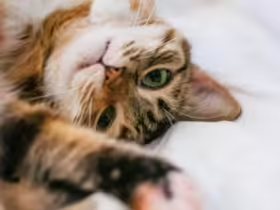Cats are known for their unique ways of communication, and meowing is one of the most common vocalizations they use. While some meowing is perfectly normal, excessive or unusual meowing can be a sign that something more is going on. In this comprehensive guide, we’ll explore the various reasons why your cat might be meowing and provide insights into how you can address their needs.
Understanding Cat Meowing
What Does Cat Meowing Mean?
Meowing is a form of communication that cats use to interact with humans and, occasionally, other animals. Unlike other vocalizations such as purring or hissing, meowing is predominantly directed towards humans. Cats meow to convey their needs, express discomfort, or seek attention. The meaning of meowing can vary depending on the tone, frequency, and context.
Why Do Cats Meow?
Here are some common reasons why your cat might be meowing:
- Attention-Seeking:
- Explanation: Cats often meow to get attention from their owners. This could be due to a need for petting, playtime, or simply companionship. If your cat is meowing persistently, they might be seeking interaction or feeling lonely.
- Hunger or Thirst:
- Explanation: One of the most straightforward reasons for meowing is hunger. If your cat’s food or water bowl is empty, they may meow to let you know they’re hungry or thirsty. Ensure your cat’s feeding schedule is consistent and their bowls are regularly filled.
- Health Issues:
- Explanation: Excessive meowing can sometimes indicate health problems. Conditions like dental issues, arthritis, or gastrointestinal problems might cause discomfort, leading to increased vocalization. If your cat’s meowing is sudden or accompanied by other symptoms, a veterinary check-up is advisable.
- Discomfort or Pain:
- Explanation: If a cat is experiencing pain or discomfort, they might meow more than usual. This could be due to an injury, a chronic condition, or an internal issue. Observing other signs such as changes in behavior, appetite, or litter box habits can help in diagnosing the problem.
- Stress or Anxiety:
- Explanation: Changes in the environment, such as moving to a new home, the arrival of a new pet, or changes in routine, can lead to stress and anxiety in cats. Meowing can be a way for them to express their discomfort or seek reassurance.
- Age-Related Changes:
- Explanation: Older cats may meow more frequently due to age-related changes. Conditions like cognitive dysfunction syndrome (similar to dementia in humans) can cause confusion and increased vocalization. Regular veterinary check-ups can help manage these changes.
- Breeding Behavior:
- Explanation: Unspayed female cats in heat often meow loudly to attract males. This is a natural part of their reproductive cycle. Spaying or neutering can help reduce this type of meowing.
- Boredom or Lack of Stimulation:
- Explanation: Cats that are bored or not mentally stimulated may meow out of frustration. Providing toys, engaging in interactive play, and creating a stimulating environment can help reduce meowing caused by boredom.
How to Address Cat Meowing
1. Assess the Context
To understand why your cat is meowing, pay attention to the context and pattern of their vocalizations:
- Time of Day: Note if the meowing occurs at specific times, such as around feeding times or late at night.
- Frequency and Intensity: Evaluate how often and how loudly your cat is meowing. Persistent and loud meowing may require more immediate attention.
2. Check for Basic Needs
Ensure that your cat’s basic needs are met:
- Feeding: Verify that your cat is getting enough food and water. Stick to a consistent feeding schedule.
- Litter Box: Ensure the litter box is clean and accessible. Cats may meow if they are uncomfortable with their litter box.
3. Veterinary Consultation
If you suspect that your cat’s meowing is due to health issues:
- Schedule a Vet Visit: A thorough examination can rule out medical conditions or provide treatment options for diagnosed issues.
- Monitor for Symptoms: Keep an eye out for other symptoms that might indicate a health problem, such as changes in appetite, weight, or litter box habits.
4. Behavioral and Environmental Adjustments
To address behavioral or environmental causes of meowing:
- Increase Interaction: Spend more quality time with your cat. Engage in play and offer affection to meet their social needs.
- Create a Stimulating Environment: Provide toys, scratching posts, and climbing structures to keep your cat entertained and mentally stimulated.
- Manage Stress: If there have been changes in the household, try to provide stability and reassurance to your cat. Gradual introductions to new pets or changes can help.
5. Training and Routine
Establishing a routine and using training techniques can help manage meowing:
- Consistent Routine: Keep feeding times, play sessions, and other activities on a regular schedule to provide predictability for your cat.
- Ignore Attention-Seeking Meowing: If meowing is solely for attention and not due to any needs, avoid rewarding the behavior by giving attention when they meow excessively. Instead, provide attention when your cat is quiet.
6. Consider Professional Help
If meowing persists despite your efforts:
- Consult a Behaviorist: A feline behaviorist can offer specialized advice and strategies for addressing persistent meowing, particularly if it’s due to behavioral issues.
- Explore Solutions: Behaviorists can also recommend environmental modifications and training techniques tailored to your cat’s specific needs.
Conclusion
Understanding why your cat is meowing is crucial for addressing their needs and ensuring their well-being. By carefully observing your cat’s behavior, addressing their basic needs, and making appropriate environmental adjustments, you can often resolve the issue. If necessary, seek professional advice to manage persistent meowing effectively.
Remember, each cat is unique, and their vocalizations are an important part of how they communicate with you. By paying attention to their meows and responding appropriately, you can strengthen your bond with your feline friend and create a more harmonious living environment.











Leave a Reply